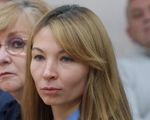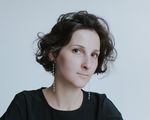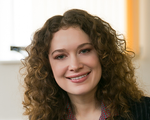About Success Builder
How do you find your place in life? How do you find something to do that both comes naturally to you and makes you happy? The answer is that you have to apply the knowledge you’ve gained from university and from life itself correctly. The Success Builder Project features HSE University graduates who have discovered themselves through an interesting business or an unexpected profession. The protagonists share their experiences and lessons learnt and talk about how they’ve made the most of the opportunities they were given.
The ability to communicate with the authorities is also a profession, especially when it is motivated not by formal duty but by a yearning for justice and respect for historical memory. State and Municipal Management master’s programme graduate Anor Tukaeva chose to become not a government official, but an activist. Her goal: use the activities of the Krokhino Foundation and ProNasledie.Media project to draw the attention of society and the state to the problem of preserving architectural monuments. In this interview with Success Builder, she explains how familiarity with the Russian hinterland changes a person’s worldview, why Russia tends to deny its past, how to build an artificial island for the sake of an idea and how an activist gets started.
What was your first educational degree and why did you decide to continue your studies?
I graduated from the MIREA Russian Technological University as a robotics engineer but realised that I didn’t want to specialise in that field. I do not have an engineering mindset at all, but as it turned out, that technical knowledge was very useful in projects related to architectural landmarks. I lacked a good liberal arts education and when I began looking around for programmes, I had no real doubt as to where to find one. Everyone knew about HSE at that time and it was highly recommended. I specifically chose the State and Municipal Management programme because it was very broad in terms of knowledge and application. In the end, we had a family consultation to discuss my choice and everyone voted ‘yes’.
What professional experience did you bring to your master’s studies?
I never had a chance to work in robotics — and hadn’t planned to, either. I entered the HSE master’s programme immediately after graduating from MIREA.
Do think it’s right to combine work and study?
If your work is related to your field of study, then it can only help. As a master’s student, I immediately went to work in the Laboratory of Municipal Administration and was already consulting full-time by my second year. This wasn’t difficult because the master’s classes were held in the evening. At HSE, you don’t have to sacrifice one for the other.
You had achieved academic success, so what stopped you from pursuing an academic career?
I am an active person by nature. I like to do things and see the result of my efforts, but academic work in the social sciences does not lead to short-term visible changes. I was not a strong student at first. In fact, I was the weakest in our class because I did not have a background in the humanities. My classmates had come to the programme from management or political science and were head and shoulders above me in many subjects.
When I got my first bad grade at HSE, I realised that switching from a technical major to the social sciences was going to be an uphill battle
I had to work very hard, but I was soon first in my class. Switching over to another field was also an important stage in my learning and a challenge to my thought processes: I had to assimilate a lot of information in a completely new field and, in general, begin thinking in a new way. This skill was very useful to me in my subsequent professional life.
My research activities in the lab and classes were interesting and necessary, and I am grateful to HSE for this. I took part in expedition projects that are still carried out today in only a few departments and schools, including cultural studies and social sciences. It is a unique experience for students and future managers who plan to live and work in Russia. They learn how everything works here and why it works as it does.
Did your relationship with HSE end with your master’s degree?
Last year, I completed an MBA course in charity management at the School of Professional Philanthropy that was organised by the Friends Foundation in cooperation with HSE. Thus, I essentially completed my third degree under the auspices of HSE.
When did you become interested in architecture and how did it become linked to your profession?
Architecture has always interested me from the point of view of aesthetics and the comfort of the living environment. This is one of the most important elements of daily life in urban culture. When I worked in the HSE School of Public Administration, I travelled quite a bit into outlying areas where I observed various processes that most people never see.
The fact that I wrote my research paper on healthcare did not prevent me from delving into other areas of life, especially considering that the architectural component of cities and villages is what catches the eye first, in addition to the abject poverty, devastation and lack of infrastructure.
It is impossible not to notice memorial sites and historically significant buildings. They are noteworthy, metaphysically dominant elements of the landscape. This became increasingly interesting to me over time and my interest in architecture gradually transformed into activism for the preservation of cultural heritage.
My trip to the flooded lighthouse church in Krokhino, which I took independently of work and study, was a turning point in terms of protecting architectural heritage. It completely changed the direction of my life. First, I started a volunteer project for preserving the landmark site in Krokhino, and then I founded a charitable foundation. Now, the charitable preservation of cultural heritage has become my profession.
What is wrong with the preservation of architectural heritage in Russia? The problem isn’t just that they install cheap plastic-frame windows in historic 17th-century buildings, right?
The main problem is that this is not a priority in the state’s policy on culture. Government officials don’t talk about the preservation of architectural heritage, create special state programmes or allocate sufficient funds for it. For the same reason, very few budgetary funds are allocated for the conservation and restoration of cultural heritage sites. The Ministry of Culture already receives far less funding than other ministries, and only 10% of that sum goes to preserving heritage sites. But, given how badly off this area is, the proportion should be reversed.
The Ministry of Culture spends most of its funds on festivals, film shoots and on everything but preserving cultural heritage
Because of this attitude on the part of the state, society itself is not as interested in this topic as it should be. What’s more, there is no systemic answer to the question of who can own and use cultural heritage sites. Approximately 30% of the sites have no owner or user and essentially hang in legal limbo. There are even some ‘non-existent’ sites: the building stands, but there is no documentation confirming its existence. It does not even have the status of ‘ownerless property’. These are ‘phantom buildings’. Our site in Krokhina had a similar story and it took us a long time to obtain approval to do any work there at all. Unfortunately, such issues are simply unsolvable without the active participation of the state.
I know from personal experience that even if you buy an architectural heritage building, no one will permit you to restore it unless you hire state workers for an outlandish fee. At the same time, no one will provide you with the funding needed to do that.
This is just the tip of the iceberg. There is no end of such problems — from the lack of necessary financial mechanisms and the extensive bureaucracy involved in putting sites to economic use to the justifiable distrust of private owners. Many precious historical buildings were ruined through barbarous methods of restoration.
I think a certain philosophical outlook is the reason for this attitude towards the past and to Russia’s heritage. In the 20th century, Soviet citizens were taught to build the future on the ashes of the old, and this wiped out the culture of preservation and creation completely. In the name of ‘progress’, people have forgotten how to preserve things and it is very difficult, especially for those in government, to let go of this paradigm, even though it’s clear that the world has changed. So far, the return to the practice of preserving our history is mostly the focus of targeted initiatives, individual institutions, charitable foundations and activist groups whose main task is to shed light on the problem, influence the state system and enlist the support of society.
This is a complex process that requires enormous resource in terms of both interacting with society and building effective communication with officials. It isn’t only a question of funding: nothing will change, even if a site is completely restored but is not integrated into the local socio-cultural environment and economic life. Any architectural landmark should have a living context.
Given your education, have you tried to play the role of a regulator to influence the process from above?
As an official, I would rarely have seen any direct result of my efforts. It is extremely difficult for me to invest resources in something abstract and not to be fully in a process with measurable change. In this sense, activism and exerting influence on a specific community through my micro-resource is more effective than exercising a sort of imaginary function that is completely divorced from the actual task. The education I received at HSE University, which was global and systemic, was more a way to see the big picture than it was to focus on a career. For me, this ability is more important and much more valuable than performing specific duties in a specific government post.
How willing are state bodies and government officials to interact with a ‘micro-resource’ like your foundation?
Our communications with officials have had mixed results. The first eight years of the foundation’s existence were very difficult, but our perseverance prompted the officials to take an interest in socio-cultural initiatives and to show some understanding of them. At first, the authorities were surprised that such public initiatives even existed. In 2017, when I was invited to meet with former Minister of Culture Vladimir Medinsky, we had been unable to resolve the bureaucratic problem by which NGOs were denied approval for conserving cultural heritage sites with no user. There is a huge number of such sites. Surprised by this, the Minister of Culture asked, ‘Are there really organisations that don’t own or use such sites, but still want to preserve them?’
If a federal official has such an attitude toward this issue, it means the state does not consider the preservation of cultural heritage a priority, no matter which changes are made to the latest version of the Constitution.
Nonetheless, the process has been put in motion. The past three years have seen the emergence of cultural volunteers as a separate branch of volunteerism in Russia, and much has been accomplished where nothing had been done before. This, even though officials high and low continue to ask, ‘Why does this even matter to you?’ They all want to figure out what we have to gain from it. In fact, it is better to let them believe we are in it for some selfish reason so that they can relax and proceed to make what they consider a mutually ‘profitable’ arrangement.
The preservation of the flooded church in Krokhino has become a model case for us. It has involved every systemic problem possible in the field of heritage preservation. We have been striving for more than eight years to make the church a de jure building. At the same time, we did not register it as a cultural heritage site to avoid having to obtain unnecessary approvals and a significant increase in the estimated cost of repairs. Now we have developed a road map of sorts that we can apply to other landmark sites.
How did your efforts for the church in Krokhino grow into a foundation?
The first task was to somehow find funding for the conservation and preservation of the lighthouse church in Krokhino. The project began in the spring of 2009 and in 2010 I established a foundation. For me, this remains a key and very telling story. This is a resource-intensive project because it took years to attract the attention of the foundation’s intended audience. Despite enormous difficulties, we have earned the trust of the community and there is now a noticeable level of activism in the field of heritage preservation. The process of conserving and restoring a flooded site is both difficult and slow. In such cases, you can’t produce a quick result soon after collecting donations. In fact, the field of heritage preservation is not the most popular type of charity in Russia.
That’s probably why we spent the first few years just convincing people not to throw rotten tomatoes at us. People who don’t understand how it all works ask us at every turn, ‘Well, how much did you manage to preserve?’ The answer is, ‘Not a lot’ because the process of restoration and conservation consists of tiny tasks that can only be accomplished slowly and meticulously: with the help of engineering surveys and design and construction work. Only after all this is it possible to carry out a project. It is better to ask how many such steps we have managed to carry out for a given project. For example, in our 10 years of work at Krokhino, we have built a man-made dam that protects the church from the effects of waves and ice, built a buttress to the northern wall of the porch, restored the masonry of the washed-out walls of the church, installed ice apron equipment that protects the island beneath the church from ice, built small bridges and much more. In fact, it can take decades to restore one such site completely.
Where does the foundation live on and how does it function?
Private individuals and corporations contribute the funding. There are also competitive grants: if you win, you get funding; if you don’t, there’s no money. For example, we have no grants for next year. We also do crowdfunding on outside platforms and sites. The money comes primarily from individuals, but sometimes from companies as well. Like all NGOs, our organisation is constantly struggling for survival.
What got you hooked on Krokhino? What is so special about it, and why don’t you just walk away from it?
Krokhino is a village that was flooded in the early 1960s due to the construction of the Volga-Baltic Waterway. A half-submerged church remains in this area — the only one preserved in Russia after the construction of canals, reservoirs and hydroelectric power stations. At one time, Krokhino was a relatively large settlement and a significant shipping hub. What’s more, the ancient city of Beloozero, that is listed as one of the 10 oldest cities of Ancient Rus, was once located at this very place. Now, the lighthouse church is all that remains of this historic place. It was not demolished because the lighthouse was used in the flood zone.
Over time, the waterway near Krokhino was straightened and the latest floating beacons were installed, making the lighthouse church obsolete. It was left to the vagaries of the water for the next 60 years. In the early years, we worked there under our own steam. Volunteers joined us from various cities, sometimes coming from such unexpected places as Nadym or Ufa, although most came from Moscow and St. Petersburg. After all possible volunteer manual labour was completed, we started the engineering, surveying and design phase.
Is this where your technical background came in handy?
Yes, I understand the general drift of what’s happening and I can monitor progress on conservation tasks. If I didn’t have an engineering degree, I’d be going crazy with so many technical terms. For the last two years, we have been stabilising the riverbank and creating an artificial island. In my opinion, this is a huge step for the heritage preservation field in Russia. Artificial islands are normally the province of the Arab Emirates and other wealthy states. But in our case, it was a public initiative supported by private donors. Our society has taken this small but very important step towards preserving its heritage!
What is happening with the foundation now? How are you modernising it?
Over the past five years, we have been involved in more than just the project in Krokhino, primarily because, in this field, it is not enough to restore only a single site if you want to make a noticeable change. This is why we began making documentary films and creating a small-scale media project, ProNasledie (About Heritage) that looks at activism in the field of cultural heritage. We also plan to rename the foundation accordingly. During our work in Krokhino, we discovered that there is a huge lack of information about protecting architectural landmarks in particular, and regarding society’s awareness of the issue of preserving historical memory in general.
Today, activism in the field of heritage preservation has become a significant non-governmental initiative, albeit in very narrow circles. The media writes more about dramas and scandals — such as when something is demolished or the reverse, when people save a site from destruction — and almost nothing about positive developments, much less about heritage activists who manage to do something with limited resources and means. And the question: ‘What can one person accomplish?’ remains a fundamental one for Russian society. I think very little such motivational material is available, but there is a great need for it and it could be life-saving — first, for people themselves, but also for our heritage sites.
Our foundation also conducts research, learns the opinions of leaders in this field and analyses existing barriers to development. We also focus on educational activities and providing expertise. As a result, we decided to rename the foundation by giving it a broader and more understandable name — ProNasledie (About Heritage), because we expanded beyond a narrow focus on Krokhino long ago. What’s more, ‘ProNasledie’ does a good job of capturing our mission and conveying what we do.
What does someone have to do to become a heritage activist?
Just join an existing team of people who are already working in the field, or else get others excited about your idea and start from scratch — if you know what you want to preserve or create. You need to start with the primary questions. If it is an architectural object, then the first step is to clarify its legal history. After that, you can develop a road map to determine what to do next.
Is pro bono legal assistance available?
You can submit a request for information yourself. A few years ago, we published a small manual on where to submit requests and what they should contain. You can obtain information from the Ministry of Culture and regional authorities responsible for culture and the preservation of cultural heritage. Generally, though, any major public organisation concerned with the protection of architectural landmarks will probably agree to speak with you because most people in this field are oriented toward ideas. We get such calls from activists once or twice a month, and we always try to help.














































































































































